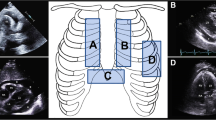Abstract
The purpose of this study was to report our clinical experience with image-guided drainage of pericardial effusions in oncology patients. IRB approval was obtained for this retrospective, HIPAA-compliant study. From November 2002 to January 2008, 40 patients underwent 43 image-guided drainages of pericardial effusions. The medical records were reviewed to analyze the technical aspects of the procedures, complications, and clinical outcomes. Thirty-three pericardial drains were placed and 10 pericardiocenteses were performed. The technical success rate was 100%. Thirty-three procedures were performed under computed tomographic (CT) guidance, five under ultrasound (US) guidance, and five using both CT and US guidance. There were no technical, procedure-related complications. Delayed postprocedure complications and arrhythmias occurred in 11 cases, for an overall complication rate of 25.6%. All complications occurred in patients who had undergone drain placement. Nine patients developed new or worsening arrhythmias and six of these patients required transfer to a higher level of care or the initiation of pharmacological management. In 58.6% of drain placements, including 4 of 11 patients who developed complications, the catheter could have been removed earlier. The median overall survival was 6.47 months (95% CI: 2.37, 12.7). In conclusion, image-guided pericardial drain placement is safe and feasible. Due to the frequency of delayed postprocedure arrhythmias, follow-up monitoring in a telemetry unit is recommended. Prompt catheter removal after drainage may reduce the incidence of delayed post-catheter-insertion arrhythmias.



Similar content being viewed by others
References
Tsang TS, Enriquez-Sarano M, Freeman WK et al (2002) Consecutive 1127 therapeutic echocardiographically guided pericardiocenteses: clinical profile, practice patterns, and outcomes spanning 21 years. Mayo Clin Proc 77(5):429–436
Rinkevich D, Borovik R, Bendett M et al (1990) Malignant pericardial tamponade. Med Pediatr Oncol 18(4):287–291
Vaitkus PT, Herrmann HC, LeWinter MM (1994) Treatment of malignant pericardial effusion. JAMA 272(1):59–64
Maher EA, Shepherd FA, Todd TJ (1996) Pericardial sclerosis as the primary management of malignant pericardial effusion and cardiac tamponade. J Thorac Cardiovasc Surg 112(3):637–643
McDonald JM, Meyers BF, Guthrie TJ et al (2003) Comparison of open subxiphoid pericardial drainage with percutaneous catheter drainage for symptomatic pericardial effusion. Ann Thorac Surg 76(3):811–815; discussion 816
Thurber DL, Edwards JE, Achor RW (1962) Secondary malignant tumors of the pericardium. Circulation 26:228–241
Posner MR, Cohen GI, Skarin AT (1981) Pericardial disease in patients with cancer. The differentiation of malignant from idiopathic and radiation-induced pericarditis. Am J Med 71(3):407–413
Maisch B, Seferovic PM, Ristic AD et al (2004) Guidelines on the diagnosis and management of pericardial diseases executive summary; the task force on the diagnosis and management of pericardial diseases of the European society of cardiology. Eur Heart J 25(7):587–610
Yeung SJ, Escalante CP (2003) Oncologic emergencies. In: Kufe DW, Pollock RE, Weichselbaum RR et al (eds) Cancer medicine, 6th edn. B.C. Decker, Hamilton, ONT, Canada, pp 2659–2680
Allen KB, Faber LP, Warren WH et al (1999) Pericardial effusion: subxiphoid pericardiostomy versus percutaneous catheter drainage. Ann Thorac Surg 67(2):437–440
Callahan JA, Seward JB, Nishimura RA et al (1985) Two-dimensional echocardiographically guided pericardiocentesis: experience in 117 consecutive patients. Am J Cardiol 55(4):476–479
Cooper JP, Oliver RM, Currie P et al (1995) How do the clinical findings in patients with pericardial effusions influence the success of aspiration? Br Heart J 73(4):351–354
Kopecky SL, Callahan JA, Tajik AJ et al (1986) Percutaneous pericardial catheter drainage: report of 42 consecutive cases. Am J Cardiol 58(7):633–635
Bruning R, Muehlstaedt M, Becker C et al (2002) Computed tomography-fluoroscopy guided drainage of pericardial effusions: experience in 11 cases. Invest Radiol 37(6):328–332
Gatenby RA, Hartz WH, Kessler HB (1991) Percutaneous catheter drainage for malignant pericardial effusion. J Vasc Interv Radiol 2(1):151–155
Marcy PY, Bondiau PY, Brunner P (2005) Percutaneous treatment in patients presenting with malignant cardiac tamponade. Eur Radiol 15(9):2000–2009
Klein SV, Afridi H, Agarwal D et al (2005) CT directed diagnostic and therapeutic pericardiocentesis: 8-year experience at a single institution. Emerg Radiol 11(6):353–363
Karam N, Patel P, de Filippi C (2001) Diagnosis and management of chronic pericardial effusions. Am J Med Sci 322(2):79–87
Merce J, Sagrista-Sauleda J, Permanyer-Miralda G et al (1998) Should pericardial drainage be performed routinely in patients who have a large pericardial effusion without tamponade? Am J Med 105(2):106–109
Soler-Soler J, Sagrista-Sauleda J, Permanyer-Miralda G (2001) Management of pericardial effusion. Heart (Br Cardiac Soc) 86(2):235–240
Keane D, Jackson G (1992) Managing recurrent malignant pericardial effusions. BMJ (Clin Res ed) 305(6856):729–730
Press OW, Livingston R (1987) Management of malignant pericardial effusion and tamponade. JAMA 257(8):1088–1092
Clarke DP, Cosgrove DO (1987) Real-time ultrasound scanning in the planning and guidance of pericardiocentesis. Clin Radiol 38(2):119–122
Spodick DH (1992) Macrophysiology, microphysiology, and anatomy of the pericardium: a synopsis. Am Heart J 124(4):1046–1051
Wong B, Murphy J, Chang CJ et al (1979) The risk of pericardiocentesis. Am J Cardiol 44(6):1110–1114
Vayre F, Lardoux H, Pezzano M et al (2000) Subxiphoid pericardiocentesis guided by contrast two-dimensional echocardiography in cardiac tamponade: experience of 110 consecutive patients. Eur J Echocardiogr 1(1):66–71
Patel AK, Kosolcharoen PK, Nallasivan M et al (1987) Catheter drainage of the pericardium: practical method to maintain long-term patency. Chest 92(6):1018–1021
Salem K, Mulji A, Lonn E (1999) Echocardiographically guided pericardiocentesis − the gold standard for the management of pericardial effusion and cardiac tamponade. Can J Cardiol 15(11):1251–1255
Kabukcu M, Demircioglu F, Yanik E et al (2004) Pericardial tamponade and large pericardial effusions casual factors and efficacy of percutaneous catheter drainage in 50 patients. Tex Heart Inst J 31(4):398–403
Author information
Authors and Affiliations
Corresponding author
Additional information
This work was accepted for oral abstract presentation at RSNA 2008.
Rights and permissions
About this article
Cite this article
Tam, A., Ensor, J.E., Snyder, H. et al. Image-Guided Drainage of Pericardial Effusions in Oncology Patients. Cardiovasc Intervent Radiol 32, 1217–1226 (2009). https://doi.org/10.1007/s00270-009-9594-7
Received:
Revised:
Accepted:
Published:
Issue Date:
DOI: https://doi.org/10.1007/s00270-009-9594-7




